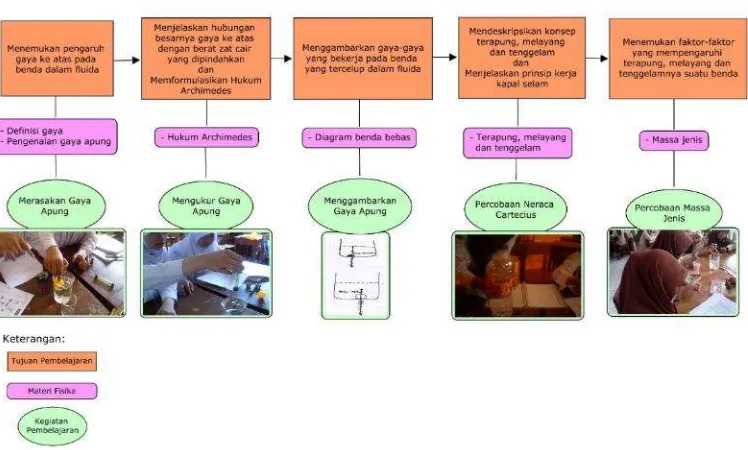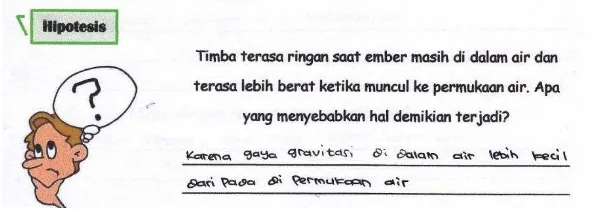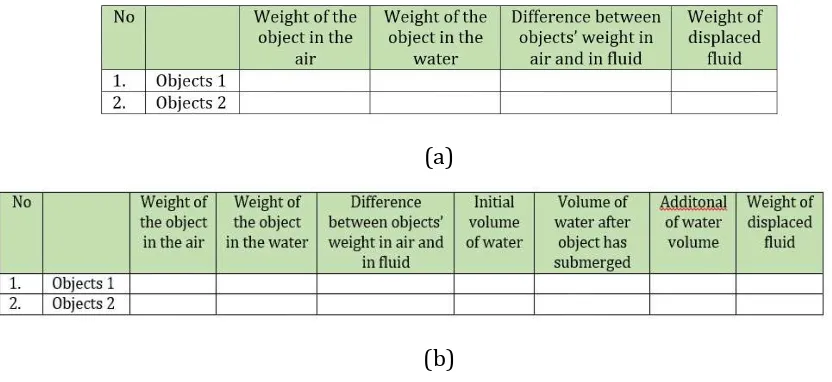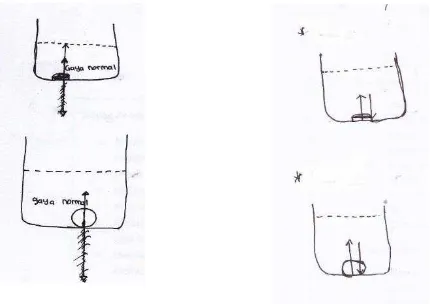HYPOTHETICAL LEARNING TRAJECTORY AND STUDENTS’ MASTERY
OF ARCHIMEDES LAW IN CLASS X SMAN 1 NORTH INDRALAYA
Fanesa Prousvaliza Ridhonakasa1, Sardianto Markos Siahaan2, Ismet3
Sriwijaya University1, 2, 3
fanesaprousvaliza@yahoo.com1, mr_sardi@yahoo.com2, ismet_physicunsri@yahoo.com3
Abstract
This research aims to know the development of students' concept mastery and produce learning trajectory in topic Archimedes Law. The methods that used in this research is design research. Conjecture of student thinking and learning activity sequence that is contained in hypothetical learning trajectory (HLT) were developed in the preliminary design phase. Then, this HLT is applied to obtain a better mastery of concept of the Archimedes Law. This HLT is applied in 2 cycle, pilot experiment and teaching experiment. Researcher use students as research subject that chosen by teacher s recommendation in the pilot experiment cycle and use 30 students of class X.3 SMAN 1 North Indralaya in teaching experiment cycle. There are changes in students' mastery of concept of buoyancy, the weight difference of object in the air and in the water, force s components that work on the object in the fluid, and the terms floating, drifting and sinking of objects overall are better. The results of this research shows that students learning sequence of Archimedes Law is from feeling the buoyant force, measuring the buoyant force, drawing the force components, and experiment using Cartesian balance, and followed by density experiment. This is done gradually and eventually students can achieve learning objectives programmed.
Key Words: Learning Trajectory, Archimedes Law, Design Research
INTRODUCTION
The success of the learning process is very depend on how teachers to pack the whole set of learning is done from stages of planning, implementation and evaluation. Study of the various components of education constantly studied to improve the quality of teaching and learning process, one of which is the renewal of the design/plan of learning (Uno, 2006).
Design of general learning activities that are written on lesson plan, better paired with the hypothesis and teacher's considerations about how students' reactions to each stage of learning trajectory. Gravemeijer (cited in Pramudiani, 2011) states, "In designing an instructional activity, a teacher should hypothesize and consider students reaction to each stage of the learning trajectories toward the learning goals." When this is done, so teacher already has a shadow anticipatory actions to be applied against the possibility problems faced by students during the learning process.
Curriculum 2013 mandates the essence of the scientific approach (Kemendikbud, 2013). Teachers as curriculum developers should be good at choosing learning activities that can stimulate students to think and act in constructing a concept. Besides selecting the learning activity, teacher should also have a shadow to the thought of what will appear from the students and the anticipation to be applied to leading to learning objectives. These shadow and anticipation are contained in hypothetical learning trajectory (HLT).
Researcher is interested in developing learning activities contained in the HLT in order to achieve meaningful learning in topic Archimedes law. This topic was chosen by reason of Archimedes law is material in class X which is often found misconceptions. Purwo (2006) identify misconceptions that occur to students on the topic of Archimedes law. Some misconceptions are found such as: 1) The buoyant force is influenced by the depth, 2) on floating objects, volume of pressed fluid is equal to volume of the object, 3) submerged objects do not have an upward force, 4) mass and gravity was included in a force. So participants can t mention and describe the acting forces on the object in fluid.
Implementation of learning in 2013 curriculum have not been implemented in all schools. Hence, selection of schools aimed in schools that have been/are being applied 2013 curriculum. SMAN 1 North Indralaya is school that currently implementing 2013 curriculum although school administrative has not been registered as a school 2013 curriculum implementers. With these all reasons, researcher concluded to do research in SMAN 1 North Indralaya.
This paper aims to describe the development of students' concept mastery and learning trajectory class X of SMAN 1 North Indralaya in topic Archimedes law as a research result that has been done. So, the research question in this paper is:
How does the learning trajectory of class X student of SMAN 1 North Indralaya in topic Archimedes Law?
THEORETICAL FRAMEWORK
buoyant force. Magnitude of buoyant force derived from the difference between objects weight in air and in fluid. Weight of fluid displaced by volume of submerged object is equal to the upward force experienced by the object. This is in accordance with Archimedes Law: upward force that act on the object that is submerged in fluid equal to the weight of displaced fluid.
In order to achieve meaningful learning in topic Archimedes law, researcher is interested in developing learning activities contained in the HLT (hypothetical learning trajectory). The term "learning trajectory was first proposed by Marty Simon in 99 Daro, Moscher, & Corcoran, 2011). HLT is term that closely related to the learning trajectory. This term refers to the guidelines for the implementation of learning as well as an anticipatory action to the possibility problems faced by students in the learning process.
According to Simon (cited in Empson, 2011) HLT is defined as:
A hypothetical learning trajectory is teaching construct – something a teacher conjectures as way to make sense of where students are and where the teacher might take them. It is hypothetical because an actual learning trajectory is not knowable in advance (p.135).
HLT is teaching construct, which is teacher s estimate to understand how students' understanding and what kind of activities that teachers can apply to on this understanding. Called a hypothesis/allegation because the actual learning trajectory has not been known before. Mulyana (2012) states, "HLT made an anticipation of what will happen, both students thinking and things that will happen in the learning process".
HLT is very important in the design of learning activities. HLT importance could be analogous to the traveling route. If we understand these possible route towards our goal then we could choose a good route. In addition we can also solve the problems we face in the class if we knew the route.
METHOD
experiment and teaching experiment. HLT first tested on a pilot experiment. In pilot experiment, researcher with teacher s recommendation choose students outside students from teaching experiment as research subjects. Purpose of this cycle is to customize the content and sequence of activities that have been developed in the preliminary design to classroom conditions, study necessity, schedules and how to implement it and then fix it to get a better design for teaching experiment cycle. Furthermore, in teaching experiment, researcher use 30 students of X.3 class as research subjects. In this teaching experiment cycle also conducted pretest, learning activity using revised HLT then continued with posttest. Data were obtained from the tests, the study documentation and interviews. Data analysis that are collected from the pre-test and post-test were analyzed by descriptive, study documentation from field notes and video recordings are summarized, selected and focused on the important data, make it easier for researchers to analyzed.
Students learning trajectory of class X SMAN North )ndralaya in topic Archimedes Law as follows:
RESULT AND DISCUSSION
Set of learning activities that were designed in preliminary design phase, then were applied to obtain a better mastery of Archimedes Law concept. Each group consisted of 5-6 students. Later, students will work in groups at every activity.
At first, teacher showing instructional video buoyancy . This video contains animated sailor that pull an anchor. Sailor felt anchor feels lighter when in the water. This video is related to the student s daily experience. Teachers ask contextual question as below:
"Timba feels light when the bucket is still in the water and feels heavier when it came to the surface water. What causes such things happen?"
All groups assume that gravity that affect differences in measurement results. Students hypothesis can be seen in Figure 2 below:
Figure 2: Hypothesis from group A
Teacher have difficulty in selecting activities that can prove students hypothesis that this happens because of gravity difference. So, teacher choose other activities by experimenting feel buoyant force. This experiments were conducted by using ping pong balls. Students press a ping pong ball submerged in a measuring cup which contains water. Through this activity the students were able to prove that there is a force acting in submerged object in a fluid, which is directed upwards namely buoyancy. Through these activities students are expected to get the answer that there is force that is acted by fluid on the submerged object in it, the buoyant force. This force causes the object feels lighter when in the water than when it is in the air, not because of influence of gravity.
"In your opinion, if the measured weight of the object, in what situation a more heavy?"
Figure 3: Slide contained with images of two situation of an object
Overall student answers stated that weight measurement results will be greater when measured in air (situation a). Students' initial understanding that there are differences in the measurement of body weight in the water and in the air are correct.
Activity of measuring the weight of spilled water replaced by counting the increase of water volume was revised,. Thus, measurement results table on the student s worksheet also changed from the table in Figure 4.(a) to the table in Figure 4.(b) below:
(a)
(b)
Figure 4: (a) Measurement result table before revised (b) Measurement result table after revised
The third activity is drawing the buoyant force. Many students who do not understand how to describe the free-body diagram (see Figure 5).
Figure 5: Student work in drawing free body diagrams on object submerged in a fluid From pictures above, it appears that students ability in describing the components of the forces acting on the body in fluids is still lack. Students can not mention the forces acting on the body is submerged in a fluid. Therefore, teachers first need to provide students with the matter of how to draw a free-body diagram. In this activity students are asked to draw the components of force acting in submerged object in fluid.
Forth activity is experiment using Cartesian Balance. Teachers open and then asking to the students about working principle of submarine. These problems are given to stimulate students' thinking about how the submarine so that it can float and drift. Teacher asked question: "What are the factors causing floating and drifting of submarine?"
Fragment 1:students thinking of the submarine floating and drift
1. Teacher : What are the factors causing floating and drifting submarine according to group ?
2. Student 5 : According to our group, effect of mass or weight misss,,,
3. Teacher : (ow is the relationship mass with floating and drifting of submarine?
4. Student 5 : The greater the mass, submarine will sink misss,,
5. Teacher : Just before student mentioned that mass or weight. Do you think mass and weight are same?
6. Student 5 : discussing with friends in group )s it same? 7. Student 2 : Same
8. Student 4 : )t s different, weight unit is newton
9. Student 2 : Yes. And mass unit is kilogram
10.Student 5 : )t s different miss, only mass that effect floating and drifting of submarine
11. Teacher : (ow about weight?
13. Teacher : (ow about other group?
14. Student 3 : According to our group, effect of mass and volume misss Same to the case of mass from Group 1 earlier miss.. And then volume, the smaller the volume of objects more easily the objects sunk Miss) 15. Teacher : Volume factor, how the cases buoy and ball jacks?
Students still looks confused to answer the question. Then teacher asked students to do experiment to get the answer. This experiment aims for students to describe floating, drifting and sinking concept and can explain how the working principle of the submarine. This experiment were conducted using reaction tube that is positioned to be float, drift and sink in a bottle of mineral water, just the same way as submarine.
Figure 6: Student activity when conducting experiments using Cartesian balance In the end of experiment, students can explain that floating, driftng and sinking of an object is not only affected by the mass or volume of the object but affected by the object s density, fluid s density and also buoyant force.
Figure 7:Students conclusion
Designing cartecius balance until the balance function properly often take a long time. As a result, learning becomes less effective. Thus, the design of the balance Cartecius previously done by the students replaced done by the teacher. Students conduct the experiment using Cartecius balance that previously designed by teacher.
that acknowledges the concept of density. So experiment using Cartecius balance become more efficient.
Based on the analysis of pretest-posttest student response, known there are some concept changes on the topic of Archimedes law. Generally, changes in students' conceptions in Archimedes law are as follows:
Table 1: Concept changes on the topic of Archimedes Law Before learning activity After learning activity 1. Heavier objects measured in the water
than when measured in air. Students assume that submerged object in a fluid get pressure which is downward from water, so that the weight measurement will be greater when in the water. 2. The depth of fluid affects the magnitude
of bouyant force. Students assume that the greater depth submerged objects in fluid, the larger buoyant force experienced by the object.
3. There are three types of forces acting on the submerged objects in a fluid, the buoyant force, drift force and sink force. 4. Terms floating, driftng and sinking of an
object is affected by the mass of the object. Students assume that the object sinks because it has a large mass/weight.
1. Heavier objects measured in the air than when measured in the water by reason that objects in the water gets the bouyant force that causes the object to be lighter.
2. The depth of fluid does not affect the magnitude of bouyant force.
3. The forces that act on the submerged objects in fluid are bouyant force, gravity and the normal force on a sank object. 4. Terms floating, drifting and sinking of an
object is affected by the object s density and fluid s density and also buoyant force.
CONCLUSION
There are changes in students' concept mastery of concept of buoyancy, the weight difference of object in the air and in the water, force s components that work on the object in the fluid, and the terms floating, drifting and sinking of objects overall are better. The results of this research shows that students learning sequence of
Archimedes Law is from (1)feeling the buoyant force, (2)measuring the buoyant force, (3)drawing the force components, and (4)experiment using Cartesian balance, and followed by (5)density experiment.
REFERENCES
Daro, P., Moscher, F., & Corcoran, T. (2011). Learning Trajectories in Mathematics: A Foundation for Standards, Curriculum, Assessment, and Instruction. United States: Consortium for Policy Research in Education.
Empson, S. (2011). On The Idea of Learning Trajectories: Promises and Pitfalls. The Mathematics Enthusiast, 571-596.
Kemendikbud. (2013). Materi Pelatihan Guru Implementasi Kurikulum 2013 SMP/MTs [Material of Teacher Training in Implementing 2013 Curriculum] . Jakarta: Kementerian Pendidikan dan Kebudayaan Republik Indonesia.
Koeno Gravemeijer and Paul Cobb. (2006). Design Research from a Learning design Perspective. In J. v. Akker, K. Gravemeijer, S. McKenney, & N. Nieveen, Educational Design Research (pp. 45-85). London: Routledge.
Mulyana, T. (2012). Pengembangan Bahan Ajar melalui Penelitian Desain [Developing Instructional Material using Design Research]. Jurnal Ilmiah Program Studi Pendidikan Matematika STKIP Siliwangi, 126-137.
Pramudiani, P. (20 . Students Learning of Compaing the Magnitude of One-Digit and Two-Digit Decimals Using Number Line. Tesis. Palembang: Pendidikan Matematika, Universitas Sriwijaya
Purwo N, K. (2006). Pemahaman dan Miskonsepsi Siswa SMA Tarakanita Magelang tentang Hukum Archimedes dengan Metode Demonstrasi [Student s Understanding and Misconception of Senior High School Tarakanita Magelang about Archimedes Law using Demonstration Method]. Skripsi. Yogyakarta: Pendidikan Fisika, Universitas Sanata Dharma
Putri, R. I. (2012). Pendisainan Hypotetical Learning Trajectory (HLT) Cerita Malin Kundang pada Pembelajaran Matematika [Designing Hypothetical Learning Trajectory Story of Malin Kundang in Mathematics Learning]. Seminar Nasional Matematika dan Pendidikan Matematika. Yogyakarta.
Uno, H. B. (2006). Perencanaan Pembelajaran [Instructional Design]. Jakarta: Bumi Aksara.
Wijaya, A. (2009). Hypothetical Learning Trajectory dan Peningkatan Pemahaman Konsep Pengukuran Panjang [Hypothetical Learning Trajectory and Improvement of Length Measurement Concept]. Seminar Nasional Matematika. Yogyakarta.




